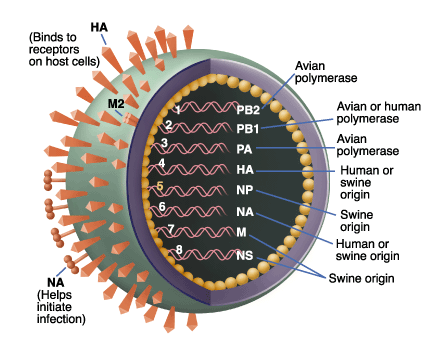
Researchers use evolutionary history to trace the early days of the pandemic.Closely related forms of the H1N1 strain of influenza virus circulated undetected in swine for years, a study published online June 11 in Nature reports. The virus, which has spread to multiple continents, has now been classified by the World Health Organization as a pandemic. "Based on this report, we had a virus circulating in pigs for 10 years and nobody knew anything about it because we were not doing proper surveillance," says Daniel Perez, an influenza expert at the University of Maryland in College Park.
Researchers traced the sordid past of the H1N1 virus by comparing mutations among different strains of the virus. Genetic sequences of 15 swine influenzas from Hong Kong and two human H1N1 viruses were compared with 796 sequences representing a large spectrum of related strains from humans, birds and pigs.
Analyzing numbers of mutations allowed an international team of researchers to estimate how long ago the strains first existed. Virus strains more than 90 percent identical to the current H1N1 strain were circulating in pigs between 9.2 and 17.2 years ago, the researchers found. The current strain "evidently spread without anyone noticing it for 10 years," says Michael Worobey, an evolutionary biologist at the University of Arizona in Tucson and one of the study's authors. "We need to spend more energy looking at what's in pigs."
"Any estimate like this has a certain amount of uncertainty to it," Worobey says. Although the numbers are not exact, he says, the data clearly show that a similar version of the virus was around long before anyone was aware of it. The report also shows that each bit of the current virus's DNA had been circulating on its own and primarily in pigs for years before combining to form the virus responsible for the current pandemic. Some genes have been in pigs for decades. "Across the genome, this is something that came from pigs," Worobey says.
Some of these DNA segments came from a North American swine influenza virus, which itself is made of bits of avian, human and swine influenzas (called a triple-reassortant strain). Other segments came from Eurasian swine with avian virus components. The combination of the triple-reassortant strain from North America and the avianlike strain from Eurasia probably happened as live pigs were transported between North America and Eurasia, the authors say.
"We can do all the surveillance we want in humans, but if we really want to prevent pandemic influenza..., a fundamental change in efforts on the animal health side has to be made," Perez says. On the same day the new report appeared, the World Health Organization classified the H1N1 outbreak as a pandemic, defined as showing sustained person-to-person transmission in many parts of the world.
WHO Director-General Margaret Chan said that the organization is raising the alert level after determining that flu cases are now showing up in people who didn't bring it from another region and weren't in contact with such travelers. "Further spread is considered inevitable," Chan said in a news conference.
"This does not mean that there is any difference in the level of severity of the flu," he said. Rather, the pandemic label "is important because it does send the strong message that the virus is here, it's in all likelihood here to stay, and it's important that we continue our aggressive efforts to prepare and respond." So far no decision has been made to mobilize pharmaceutical companies to start mass-producing vaccines aimed specifically at the novel H1N1 virus. But preliminary steps to make that a seamless move have already been taken.
Source: www.sciencenews.org
No comments:
Post a Comment